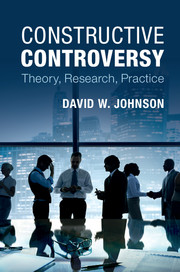Book contents
- Frontmatter
- Contents
- List of figures
- List of tables
- Acknowledgments
- 1 Underlying foundations of constructive controversy
- 2 The nature of constructive controversy
- 3 Theory of constructive controversy
- 4 The processes of constructive controversy and concurrence seeking
- 5 The outcomes of constructive controversy
- 6 Conditions mediating the effects of constructive controversy
- 7 Constructive controversy and decision making
- 8 Constructive controversy in education
- 9 Constructive controversy and political discourse in democracies
- 10 Constructive controversy, creativity, and innovation
- 11 Constructive controversy and building and maintaining peace
- 12 Conclusions
- References
- Index
1 - Underlying foundations of constructive controversy
Published online by Cambridge University Press: 05 June 2015
- Frontmatter
- Contents
- List of figures
- List of tables
- Acknowledgments
- 1 Underlying foundations of constructive controversy
- 2 The nature of constructive controversy
- 3 Theory of constructive controversy
- 4 The processes of constructive controversy and concurrence seeking
- 5 The outcomes of constructive controversy
- 6 Conditions mediating the effects of constructive controversy
- 7 Constructive controversy and decision making
- 8 Constructive controversy in education
- 9 Constructive controversy and political discourse in democracies
- 10 Constructive controversy, creativity, and innovation
- 11 Constructive controversy and building and maintaining peace
- 12 Conclusions
- References
- Index
Summary
INTRODUCTION
“NO! NO! NO! NO!” yelled one artist to another as he viewed what the other had painted during the day. “You do not understand! This is not what we are trying to do!” “It is you who do not understand!” the other replied. “This is what we talked about this morning!” “This is exactly what we are trying to achieve!”
Such heated discussions were common between two of the greatest painters of the early twentieth century. They had an intense creative collaboration filled with conflict. They dressed alike, in mechanics’ clothes, and jokingly compared themselves to the Wright brothers (Orville and Wilbur). From about 1908 to 1912, they saw each other almost every day, talked constantly about the revolutionary new style they were developing, and painted as similarly as possible. Many of their respective works from those years were indistinguishable. In many cases, only art experts could or can distinguish between a painting by one or the other. They were deeply committed to their goal of creating a new style. Usually, they would meet for breakfast to discuss what they planned to paint during the day, and then spend all day painting separately. Each evening, they would rush to the other's apartment to view what the other had done, which they proceeded to criticize passionately. A canvas was not finished until the other painter said it was. They engaged in intense conflicts about the nature of the new style they were trying to create and the way in which they were expressing it in their paintings. One of the painters described it as climbing a mountain together, being roped together, knowing their survival depended on each other. The disagreements and conflicts over the nature and direction of their work were intense, spirited, illuminating, and remarkable. One of the painters stated that the things they said to each other would never be said again, and even if they were, no one would understand what was meant anymore.
- Type
- Chapter
- Information
- Constructive ControversyTheory, Research, Practice, pp. 1 - 20Publisher: Cambridge University PressPrint publication year: 2015



